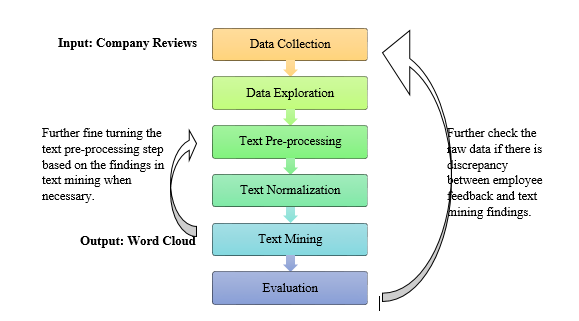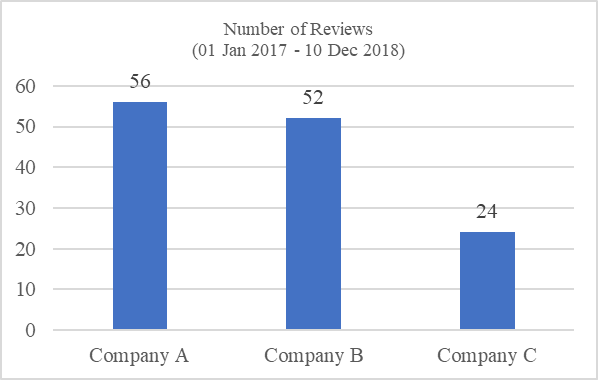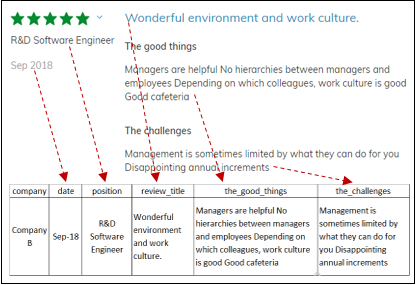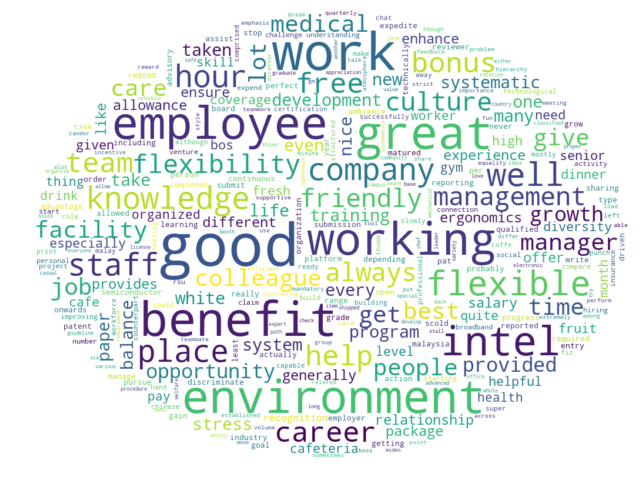Abstract
During a job searching process, the condition of a company is always one of the considering factors to assist job seekers in their job selection process. Basically, job seekers are interested to know about the company environments, benefits as well as problems. In the old days, this information can only be obtained from company’s employees if by any chance the job seekers know anyone in the company. Nowadays, the job seekers can also get to know the company environment through the reviews posted by company’s employees. However, reading long reviews may be time consuming. Hence in this work, a text analytics pipeline (including cleaning, lemmatization and mining) is proposed to develop quick visuals solutions for job seekers to gain a quick insight about companies as well as making a quick comparison between companies if needed. Specifically, this study focuses on review contents of “the good things” and “the challenges” which represented positive and negative reviews about the company respectively. For evaluation, job reviews from three multinational companies were used. Feedbacks from the respective company’s employees were obtained to verify whether the presented outcomes from the visuals are accurate and informative in representing positive (good things) and negative (challenges) about their companies.
Keywords: Text miningn-gramjob reviewsinformation extractiondecision making
Introduction
Job searching is a common process experienced by most people regardless of fresh graduates or experienced workers. From job searching to successful recruitment could be a long and complicated process. With the advancement of internet, this process has become simplified and transparent where job seekers can perform their own job searching as well as evaluation based on the information contributed by public through the internet. However, it can be time consuming to read all the information.
Since the condition of a company is always an interest evaluation factor by job seekers during job searching, in this work, a text analytics technique, i.e., term frequency was used to develop a platform for job seekers to gain quick insight about their shortlisted companies. The data source used in this work is the company reviews posted by employees in JobStreet. Three multinational companies were selected for the study and evaluation of the reliability of the proposed technique. The outputs of this work are word clouds that represent the pros and cons of each company, which can provide quick insights about each company as well as offering comparison between companies.
Problem Statement
In general, there are few factors considered by job seekers during job searching process. Company related information is usually one of the most crucial factors to be considered. Today, performing company background check through internet is a common practice by many job seekers to gain better understanding about a company such as the company nature, business model etc ( Stone, Neely, & Lengnick-Hall, 2018). During company background check, information about the company environment, company culture, employee’s benefits as well as the comments from the existing employees are important information that the job seekers are looking for.
Traditionally, this type of internal information could be obtained through family, friend or friend’s friend who have experience working with that company. However, the information gathered through this traditional way is limited. Nowadays, some job searching platforms such as JobStreet or Indeed allow employees to provide their personal comments about the company in the online platforms. These practices offer new opportunity for the job seekers to understand about a company from a whole new and genuine internal perspective rather than just solely depending on the information available on the company websites. ( Schneider, Wickert, & Marti, 2017). However, it could be time consuming to review all the comments to identify the pros and cons about a company. In addition, a job searching process will usually involve more than one company. Therefore, an effective mechanism is needed assist in the review of all the employees’ comments.
Research Questions
In this work, the goal is to propose a text analytics solution for job seekers that improve the efficiency of job searching process. The research questions to guide the work as follows:
How text analytics can be applied to improve job searching process?
What kind of texts are suitable for text analytics in job searching process?
What insights can be obtained from simple text analytics component like Word Cloud?
Can simple text analytics help to improve the targeted issue of job search process?
Purpose of the Study
The purpose of this work is to propose a text analytics pipeline (including cleaning, lemmatization and mining) that allow effective usage of the available information. This pipeline will produce visual solutions from information for job seekers to gain a quick insight about companies as well as making a quick comparison between companies.
Research Methods
In this section, the pipeline of text analytics (on the company reviews posted in JobStreet) is proposed to offer a quick insight about the shortlisted companies. The tools using in this work were Jupyter Notebook and Python in Intel IA Dev Cloud. Online NGram Analyzer was also used for certain checking or testing. The overall flow of text analytics is as below (Refer Figure

Data Collection
The data using in this work are company reviews posted by companies’ employees in JobStreet website. At the initial stage of work, three well-known companies in Penang were selected, namely Company A, Company B and Company C. A total of 132 reviews posted from 01 Jan 2017 to 10 Dec 2018 were collected from JobStreet website ( JobStreet.com Malaysia, 2018) and the review distribution of the companies is shown in Figure

The data size might be insufficient to provide a comprehensive information about the company but it should be sufficient to provide basic significant insight. The company reviews collected from JobStreet website were transformed into Excel table for further processing. The data collection and transformation process are summarised in Figure

Data exploration
After the data collection, exploration and inspection were performed to ensure the validity of the data collected. There were 132 rows and 6 columns in the collected data. The 132 rows are the reviews for the three companies. The descriptions for the six columns are shown below (see Table
Text Pre-processing
In this stage, data were categorized as “the_good_things” and “the_challenges” which represented the positive and negative insights of company, respectively. Since the data is unstructured data, therefore data cleaning is required. Based on Loper and Bird ( 2002), there are six steps taken in the text pre-processing process: first, tokenize the text data by using unigram tokenization; second, remove the punctuations in text data; third, remove extra whitespace between each word for standardization; fourth, convert the text to lowercase for standardization purpose. However, exception for certain words such as “US” and “IT” were applied to avoid the deviation of the word meanings. The list of exception words was designed in scalable format in Python script where new exception word can be added easily in future; fifth, remove numeric text which is not meaningful in representing the insight about company; and finally remove stop words that have no significant meaning such as “the” and “of”. The stop word list is a predefined list in Python Natural Language Toolkit (NLTK) library. In terms of tokenization, this work uses the unigram tokenization as initial evaluation (to check the feasibility to apply text analytics in job searching process). A simple testing was also performed in Online NGram Analyzer using bi-gram or more tokenization to check if there are any significant outputs. The findings will be further discussed in Text Mining section.
Text Normalization
After the text pre-processing step, the cleaned text data require additional step for standardization. The wording or format standardization step is called text normalization. In general, there are two types of normalization, which are stemming and lemmatization. Stemming is a process to convert the word to its stem which is a good method to standardize different wording with same stem. However, stemming was not used because it would produce invalid wording which could bringing difficulty to understand the outputs of analytics (word clouds). Lemmatization is another method to standardize the text. The output of lemmatization is valid word which overcome the issue in stemming. It might not as good as stemming in standardizing the word to stem word, but it is good enough in basic wording standardization such as plural convert to singular. Thus, lemmatization is applied to normalize the text data in this work.
Text Mining
In order to identify the significant insights from the company reviews, basic text analytic technique which is term frequency or word count has been applied. An assumption is that the frequent term in the reviews would be more likely representing the insight about the company. There are two types of graphics used to represent the frequent words: word cloud and histogram. The word cloud provides quick glance insight about the company for job seekers. Meanwhile the histogram visualize the quantitative information about word frequency. This graphical output was only be used as a reference in the development stage, not to deliver as final output for job seekers.
As the objective of work is to provide a quick insight about positive and negative of each company, thus, there would be different word clouds to represent positive and negative reviews. Since there are three companies were selected for in this study, a total of six word clouds will be generated to represent the positive and negative comments about the three companies.
In the analysis of preliminary graphics developed from normalized text data, words with less significant meanings were found. These less meaningful words such as “also” and “may” were categorized as stop words, which was then removed during the text pre-processing stage. Besides, it was also found that the preliminary word cloud was rather crowded as showed in Figure

Thus, term reduction was applied to reduce the term with frequency of 2 or below as it is least likely to represent the company insight. However, only 24 reviews were available for Company C which is half the size of the reviews available for Company A and Company B. After removed the term with frequency ≤ 2 for Company C, it was only left less than 20 terms. Thus, the term reduction for frequency ≤ 1 was applied for the reviews of Company C. In overall, 83.7% of terms were reduced as shown in Table
By removing the identified less meaningful word and apply term reduction, the new word clouds have been developed and illustrated in Table
Table
As mentioned in Text Pre-processing section, a quick analysis is conducted using Online NGram Analyzer ( Ngram Analyzer, 2018) by applying bi-gram or more tokenization to explore if there is any additional information. There are some frequent and significant ngram term found as showed in Table
However, Online NGram Analyzer is not a good platform to achieve the objective of this work due to the manual step needed to input the text, plus there is no text normalization feature (e.g. stemming and lemmatization). Online NGram Analyzer was just used as a quick check to assess whether different n-gram provide additional insights about the company in this work. Thus, expanding the unigram word cloud developed by Python to cover bi-gram or more tokenization is a potential future enhancement.
Findings
In this work, qualitative evaluation method is used to evaluate two components: reliability of the data collected from JobStreet, and usability of word cloud platform to represent the company’s insight. In the evaluation part, the feedbacks from some company’s employees have been collected to verify whether the word clouds in Table
Overall, the company’s employees agreed that the word clouds correctly portray the goods and challenges of their companies. However, there are some minor specific feedbacks from employees which were different from the insights gained from word cloud. It was further check and discussed in Table
Discussion
The objective of work is to provide a platform for job seekers to gain quick insight about the company. In this work, word clouds used as platform to provide such insight to the job seekers. Overall, the word cloud (refer to Table
There are some challenges faced in this work such as size of data etc. Thus, future enhancement is needed to produce more accurate and informative outputs. As a preparation for future enhancement, the Python script was designed in a user friendly and scalable structure. The stop word list and lowercase exception list is expandable from time to time for newly detected word.
Other than job seekers, this solution (word clouds) is also applicable for company human resource (HR) personal for better understand the employee perspective and take necessary action as an employee retention approach. Besides, the HR personal can also understand the benefit offered by competitor companies in analysing the employee’s needs and leaving reasons.
Conclusion
In conclusion, the proposed text analytics solution and its output (word clouds) has been evaluated by expert (company employee). In overall, the word clouds can serve as a platform to provide overall and quick insight about the company. The quick insight is a good reference and save time for job seekers in job searching process. It is also a good platform for HR personal to study and understand the employee’s need and the challenges facing. In this work, the company reviews presented in word clouds are sufficient to provide quick glance on the main insight about the company. However, the improvements such as more data, expand the unigram tokenization are needed for more accurate and informative insights.
Acknowledgments
This research is supported by Fundamental Research Grant Scheme (FRGS), Ministry of Education Malaysia (MOE) under the project code, FRGS/1/2018/ICT02/USM/02/9 and title, Automated Big Data Annotation for Training Semi-Supervised Deep Learning Model in Sentiment Classification.
References
- JobStreet.com Malaysia (2018). Company Profiles and Reviews - JobStreet.com Malaysia. Retrieved from: https://www.jobstreet.com.my/en/companies/xxxxxx/reviews
- Loper, E., & Bird, S. (2002). Proceedings of the ACL-02 Workshop on Effective Tools and Methodologies for Teaching Natural Language Processing and Computational Linguistics. https://doi.org/10.3115/1118108.1118117
- Ngram Analyzer (2018). Retrieved from: http://guidetodatamining.com/ngramAnalyzer/
- Schneider, A., Wickert, C., & Marti, E. (2017). Reducing complexity by creating complexity: A systems theory perspective on how organizations respond to their environments. Journal of Management Studies, 54(2), 182-208.
- Stone, C. B., Neely, A. R., & Lengnick-Hall, M. L. (2018). Human resource management in the digital age: Big data, HR analytics and artificial intelligence. In Management and technological challenges in the digital age (pp. 13-42). CRC Press.
Copyright information

This work is licensed under a Creative Commons Attribution-NonCommercial-NoDerivatives 4.0 International License.
About this article
Publication Date
30 March 2020
Article Doi
eBook ISBN
978-1-80296-080-8
Publisher
European Publisher
Volume
81
Print ISBN (optional)
-
Edition Number
1st Edition
Pages
1-839
Subjects
Business, innovation, sustainability, development studies
Cite this article as:
Chiew, S. C., Hoon, G. K., & Samsudin, N. H. (2020). Text Analytics On Company Reviews In Jobstreet. In N. Baba Rahim (Ed.), Multidisciplinary Research as Agent of Change for Industrial Revolution 4.0, vol 81. European Proceedings of Social and Behavioural Sciences (pp. 597-607). European Publisher. https://doi.org/10.15405/epsbs.2020.03.03.69
